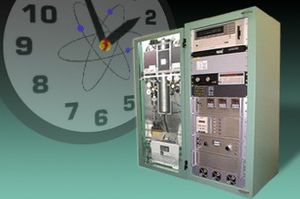Atomic clock facts for kids
An atomic clock is a super precise clock that uses the natural vibrations of atoms to tell time. Unlike regular clocks that use gears or pendulums, atomic clocks rely on the tiny, steady movements inside atoms. This makes them the most accurate clocks in the world! They are sometimes called primary clocks because they set the standard for time.
Most clocks measure time by counting how many times something swings back and forth, like a pendulum. Atomic clocks do something similar, but they count how many times an atom "wiggles" or vibrates. These vibrations are incredibly fast and consistent.
Contents
How Atomic Clocks Work
Atomic clocks work by measuring the exact frequency of radiation given off by electrons as they move between energy levels in an atom. Think of it like a tiny, perfect pendulum swinging billions of times per second. The most common type of atomic clock uses caesium atoms.
The Science Behind the Tick
Inside an atomic clock, atoms are cooled down and then exposed to radio waves. When the radio waves are at just the right frequency, the atoms change their energy state. The clock then "locks on" to this exact frequency. This frequency is incredibly stable and doesn't change, making atomic clocks super reliable.
Why Atomic Clocks Are Important
Atomic clocks are vital for many modern technologies. Because they are so accurate, they help us with things like:
- GPS (Global Positioning System): Your phone's GPS needs incredibly precise timing to figure out your location. Atomic clocks in satellites send out signals that your phone uses to calculate distance.
- Internet and Communication: Keeping computer networks and communication systems in sync across the globe relies on atomic time.
- Scientific Research: Scientists use atomic clocks for experiments that need exact time measurements, like studying gravity or testing new physics theories.
Global Timekeeping
There are more than 260 atomic clocks located in over 60 different places around the world. All the information from these clocks is sent to the International Bureau of Weights and Measures in Paris, France. Here, scientists combine all the data to calculate the International Atomic Time (TAI). This is the world's official time standard.
Who Invented the Basics?
The basic ideas behind atomic clocks were developed by Isidor Isaac Rabi. He was an American physicist who worked at Columbia University. He won the Nobel Prize in Physics in 1944 for his work on how atoms behave in magnetic fields. His discoveries helped pave the way for atomic clocks.
Images for kids
-
The master atomic clock ensemble at the U.S. Naval Observatory in Washington, D.C., which provides the time standard for the U.S. Department of Defense. The rack mounted units in the background are Microsemi (formerly HP) 5071A caesium beam clocks. The black units in the foreground are Microsemi (formerly Sigma-Tau) MHM-2010 hydrogen maser standards.
-
Louis Essen (right) and Jack Parry (left) standing next to the world's first caesium-133 atomic clock (1955)
-
An experimental strontium-based optical clock
-
May 2009– JILA's strontium optical atomic clock is based on neutral atoms. Shining a blue laser onto ultracold strontium atoms in an optical trap tests how efficiently a previous burst of light from a red laser has boosted the atoms to an excited state. Only those atoms that remain in the lower energy state respond to the blue laser, causing the fluorescence seen here.
-
One of NIST's 2013 pair of ytterbium optical lattice atomic clocks
-
JILA's 2017 three-dimensional (3-D) quantum gas atomic clock consists of a grid of light formed by three pairs of laser beams. A stack of two tables is used to configure optical components around a vacuum chamber. Shown here is the upper table, where lenses and other optics are mounted. A blue laser beam excites a cube-shaped cloud of strontium atoms located behind the round window in the middle of the table. Strontium atoms fluoresce strongly when excited with blue light.
See also
 In Spanish: Reloj atómico para niños
In Spanish: Reloj atómico para niños















